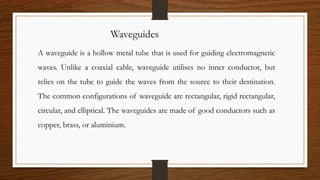Lecture 6-3transcription of dicible of power
- 1. MICROWAVE ENGINEERING Lecture 6 Academic year 2023-2024
- 2. TRANSMISSION LINES AND WAVEGUIDES
- 3. TRANSMISSION LINES AND WAVEGUIDES INTRODUCTION Transmission lines and waveguides are used in communication as wired media (or channels) to guide the electromagnetic energy from one point to another. A transmission line consists of two or more conductors separated from one another by a dielectric, like air, pressurized gas or an insulating material such as polythene, teflon.
- 4. Waveguide consists of a hollow tube, which is either rectangular, or cylindrical. Transmission lines are usually used to guide transverse electromagnetic waves (TEM), whereas waveguides are used to guide transverse electric (TE) or transverse magnetic (TM) waves.
- 5. TRANSVERSE MODES OF ELECTROMAGNETIC WAVES Electromagnetic waves were described as energy that radiates from a source or as oscillations that propagate through the free space with a velocity of light (3× m/s). It was also said that an electromagnetic wave consists of an electric field E and magnetic field H that are at right angles with each other.
- 6. Transverse Electromagnetic (TEM) Mode The concept of transverse electromagnetic waves (TEM) was also introduced, where it was said that the electric field E and the magnetic field H oscillate in phase with each other and are perpendicular to the direction of propagation, z; that is, the direction of propagation is at right angle with both electrical and magnetic field. This means that there is no longitudinal (or z-directed) electric and magnetic fields; that is, Ez and Hz are zero.
- 7. Transverse Electromagnetic (TEM) Mode (cont.) This mode of propagation is used by most of the transmission lines and its cut-off frequency is zero. However, for it to be used in transmission lines, there must be at least two distinct conductors that are separated by an insulating material, hence they cannot propagate in a waveguide.
- 8. Transverse Electric (TE) Mode In transverse electric (TE) mode, there is no longitudinal or z-directed electric field, whereas the magnetic field is present in the direction of propagation; that is, Ez = 0, and Hz ≠ 0, hence TE waves are also referred to as H-waves. This mode of propagation is used by waveguides and some transmission lines and its cut-off frequency is greater than zero.
- 9. Transverse Magnetic (TM) Mode In transverse magnetic (TM) mode, there is no longitudinal or z-directed magnetic field, whereas the electric field is present in the direction of propagation; that is, Hz = 0, and Ez ≠ 0, hence TM waves are also referred to as E-waves. This mode of propagation is used by waveguides and some transmission lines and its cut-off frequency is greater than zero.
- 10. WAVEGUIDES AND MICROWAWE TRANSMISSION LINES Transmission lines are devices that guide electromagnetic waves from one place to another. For lower frequencies, two wire transmission lines are used.
- 11. This type of a transmission line is limited to low frequencies due to radiation loss at high frequencies. their main drawback is limited power- handling capabilities.
- 12. To overcome some of the problems mentioned above, waveguides are used at microwave frequencies because of their all-round characteristics, which are better than most of the transmission lines, especially when it come to power-handling capabilities
- 13. In addition to the waveguide, other types of microwave lines include miniature class of transmission lines which are designed for higher frequencies up to millimetre wave bands. These include the microstrip, stripline and coplanar waveguide.
- 14. Waveguides A waveguide is a hollow metal tube that is used for guiding electromagnetic waves. Unlike a coaxial cable, waveguide utilises no inner conductor, but relies on the tube to guide the waves from the source to their destination. The common configurations of waveguide are rectangular, rigid rectangular, circular, and elliptical. The waveguides are made of good conductors such as copper, brass, or aluminium.
- 15. The inner walls of the waveguide have a very shallow skin depth resulting in a very little current existing in the surface of the inner walls of the waveguide, hence little power is dissipated in the guide; that is, waveguide walls dissipate negligible small power, thus making them to act as a mirrors to reflect the waves down the hollow tube.
- 16. Rectangular waveguide The rectangular waveguide is the waveguide with a rectangular cross section and is the most commonly used to couple transmitters or receivers to the antenna. Rectangular waveguide
- 17. Waveguides only propagate frequencies above a given cut-off, which is determined by the width of the waveguide. These limits on wavelength and frequency are given by the following equations, respectively, and are such that a half-wavelength of the propagated signal fits in the wide dimension of the waveguide.
- 19. END THANKS


















